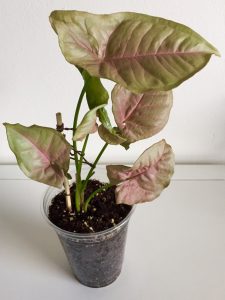We all want our arrowhead plants to look vibrant and boost indoor space appearance. But arrowhead plant leaves turning pale can be worrying. Many houseplant enthusiasts end up panicking by trying to fix the issue without identifying the exact cause.
Understanding the causes of pale leaves on arrowhead plants can be a daunting experience among many indoor plant enthusiasts. This article explains the causes and tips for fixing these arrowhead plant leaf problems.

Causes of Arrowhead Plant Leaves Turning Pale
Overwatering
Overwatering can cause arrowhead plant leaves to turn pale. When the plant is consistently exposed to excessive water, the roots become waterlogged, leading to poor oxygen availability and root rot. The plant’s ability to absorb nutrients and water is compromised, leading to pale leaves.
It is important to ensure proper drainage for the arrowhead plant. Choose a well-draining potting mix and make sure the pot has drainage holes. Allow the soil to dry out partially between waterings.
Always check the moisture level of the soil before watering. If it feels moist, wait for it to dry out before watering again. Consider using a moisture meter to accurately assess soil moisture. You can also choose an appropriately sized pot for the plant to reduce overwatering risk.
Underwatering
Underwatering can also cause arrowhead plant leaves to turn pale. When the plant doesn’t receive enough water, it becomes dehydrated, leading to wilting and pale leaves. Insufficient water availability hinders the plant’s ability to carry out essential processes like photosynthesis.
It is crucial to establish a regular watering routine for your arrowhead plant. Check the soil moisture regularly by sticking your finger into the soil. If it feels dry, it’s time to water. Water the plant thoroughly, allowing water to flow out of the drainage holes.
Monitor the moisture levels of the soil and adjust your watering frequency accordingly. Consider factors like temperature, humidity, and the plant’s growth stage when determining watering needs. In drier conditions or warmer seasons, you may need to increase the frequency of watering.
Incorrect Lighting
Incorrect lighting can be a reason behind pale leaves in arrowhead plants. These plants thrive in bright, indirect light. Insufficient light or exposure to direct sunlight can cause the leaves to lose their vibrant color and appear pale or yellowish.
Place your arrowhead plant in a location where it can receive bright, indirect light. Avoid exposing it to direct sunlight, especially during the intense midday hours when the sun’s rays can be too harsh. Relocate to a north or east-facing window where the plant can receive filtered sunlight.
Before bringing home an arrowhead plant, assess the lighting conditions in your space and choose a suitable location accordingly. If you notice the leaves turning pale, adjust the plant’s position to a spot with better lighting.
Lack of Humidity
A lack of humidity can contribute to pale leaves in arrowhead plants. These plants are native to tropical regions with high humidity levels, and when they are exposed to dry air, their leaves can lose moisture and appear pale or dull.
Use a humidifier to increase the moisture levels in the air around the plant. Another method is to create a microclimate by placing the plant on a tray filled with water and pebbles. As the water evaporates, it will increase the humidity around the plant.
Grouping plants together can create a microclimate with higher humidity levels. You can also place the plant in a room with naturally higher humidity, such as a bathroom or kitchen. Avoid placing the plant near sources of dry air, such as heating vents or drafts.
Temperature Fluctuation
Temperature fluctuations can impact the coloration of arrowhead plant leaves, causing them to turn pale. These plants prefer stable and moderate temperatures. Exposure to extreme temperatures, both hot and cold, can stress the plant and lead to pale or discolored leaves.
Keep the arrowhead plant in an environment with consistent temperatures. Avoid placing the plant near drafty windows, air conditioning units, or heating vents. Maintain a moderate temperature range between 60°F (15°C) and 75°F (24°C) for optimal growth.
Choose a suitable location for the plant that provides stable temperatures throughout the day. Avoid placing the plant near doors or windows that are frequently opened, as this can expose it to temperature variations.
Nutritional Deficiency
This issue can also contribute to pale leaves among arrowhead plants. These plants require a balanced supply of essential nutrients for healthy growth. Insufficient nutrients, particularly nitrogen, iron, or magnesium, can result in chlorosis, causing the leaves to turn pale or yellowish.
Provide the arrowhead plant with a balanced fertilizer formulated for houseplants. Look for a fertilizer with a higher nitrogen content to promote leaf growth and green coloration. Follow the instructions on the fertilizer package for application rates and frequency.
Regular fertilization will ensure the plant receives adequate nutrients. During the growing season, fertilize the arrowhead plant every four to six weeks. Be cautious not to over-fertilize, as it can lead to fertilizer burn and other issues.
Plant Diseases
Plant diseases can cause arrowhead plant leaves to turn pale. Common diseases that affect these plants include leaf spot diseases, powdery mildew, and root rot. These diseases can weaken the plant’s overall health and lead to pale, discolored leaves.
Identify the specific disease affecting your arrowhead plant. Remove and discard any infected leaves or plant parts to prevent the disease from spreading. If the disease has progressed significantly, you may need to consider seeking professional advice.
Maintaining good plant hygiene and providing optimal growing conditions. Avoid overwatering, as it can create a favorable environment for disease development. Ensure proper airflow around the plant by spacing it adequately from other plants.
Pest Infestation
A pest infestation can cause arrowhead plant leaves to turn pale. Common pests that affect these plants include spider mites, aphids, and mealybugs. These pests feed on the plant’s sap, weakening its vitality and causing the leaves to appear pale or discolored.
Identify the specific pest affecting your arrowhead plant. Use organic insecticidal soap or neem oil to control pests. Apply the solution according to the instructions on the product label, ensuring thorough coverage of both upper and lower leaf surfaces. Repeat the treatment as necessary.
Regular inspection of the plant for any signs of pest activity. Quarantine newly acquired plants to prevent introducing pests to your existing collection. Maintaining good plant hygiene, such as removing dead leaves or debris, can also discourage pest infestations.
Root-bound Issue
A root-bound issue can contribute to pale leaves in arrowhead plants. When the plant becomes root-bound, its roots outgrow the current pot, leading to crowded and compacted roots. This restricts the plant’s access to water and nutrients, resulting in pale and stunted growth.
Transplant your arrowhead plant into a larger container. Choose a pot that is one size larger than the current one and has drainage holes. Gently remove the plant from its current pot, loosen the root ball, and place it in the new pot with fresh, well-draining soil.
Regular repotting and provision of adequate space for root growth. As the arrowhead plant grows, monitor its root system and repot every one to two years, or when you notice signs of being root-bound. Be careful not to damage the roots when repotting to ensure healthy root development.
Final Thoughts from Experts
Dealing with arrowhead plant leaves turning pale may sound simple and easy. But reviving severe leaf discoloration among syngonium plants isn’t a walk in the park. We recommend providing appropriate growing conditions and a suitable environment.
Improper soil moisture due to overwatering is the leading cause of Syngonium plant leaves turning pale. Take the time to examine and investigate your houseplant to identify the exact cause. The exact cause will help you devise an immediate solution and implement preventive measures.
People Who Read This Also Read:






